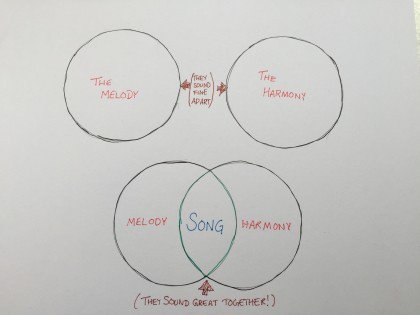Mike Vardy's Blog, page 71
June 16, 2016
Why Journaling Is A Simple Way To Boost Personal Productivity

I’m a firm believer in looking inward to find ways to move ahead. For me, journaling is a powerful tool in this process. Putting pen to paper on a regular basis – even if for only a few minutes per day – deepens your connection to the work you’re doing. This simple step allows you to review your progress and helps ensure that you move in the right direction.
Reviewing your work and how you feel about your work is something Productivityist heavily emphasizes. Mike encourages our team to conduct self-reviews bi-weekly, quarterly, and yearly.
Review is essential to evaluation, which is essential to progress.
Journaling (or, if you prefer, recording or documenting) is the key tool to help you with the review process.
Journaling Builds Awareness
Journaling clarifies jumbled thoughts and feelings. When you know where the problems lie, this allows you to focus on what you enjoy, struggle with, and want to pursue.
It also allows you to review the past so you can assess and improve the present. While the past may be over and done with, your past continues to impact you today.
Think about your habits, ideals, and goals. These didn’t just fall out of the sky, did they? Not likely. They developed from the past. The challenge lies in that it can be tough to remember how it all came to be.
Journaling is a great way to pay attention to “how it all came to be.” In looking back, you gain insight into (and often appreciation for) your challenges, lessons, and perseverance. You take what you know and apply it to how you want to grow.
Journaling Builds Confidence
When you deepen your awareness of your past (and present) through journaling, you will see definitive patterns emerge. The ability to look back on what you’ve done gives you confidence to make decisions that move you toward what you want.
How many times have you looked at your current circumstances and wondered, “How did I get here?” or “What would things look like if I had done A instead of B?”
Sometimes the answer is clear. Other times, not so much. If you keep a journal, the odds are good that you could flip through the pages, add up a few events or decisions, and find the answer.
“How did I get here?”
Flip, flip, flip (or scroll, scroll, scroll if you’re into digital journaling).
“Well X led to Y, and then Z happened, which prevented me from doing W.
Wow, I really miss doing W. I’m going to do some W today.”
And that is the power of journaling. You review the past to assess the present and determine what actions are necessary to change your future.
The confidence you gain through breaking down your past choices will (gradually) encourage you to trust yourself. It wasn’t that you didn’t have the power or desire to do W; you were just dealing with X, Y, and Z.
This knowledge and trust reduces stress and anxiety, empowers you to make big decisions, and propels you towards your goals.
Journaling Builds Momentum
One thing that Mike has said sticks out in my mind when it comes to journaling. He said, “Your brain is meant to be a factory, not a warehouse.”
Journaling clears the mind of unproductive storage to make space for the important stuff. The stuff you want to do. The stuff you want to move forward.
In this article, Mike states, “[Journaling] helps me drill deep into what I ultimately want to do and helps me achieve it.”
Journaling helps you prioritize A when B through Z try to compete for your attention. It’s what’s shows you how you balanced A, B, and C in the past so you can now manage D through F. It’s what gives you the confidence to make a decision when you reach a fork in the road with two, four, or 26 potential paths.
Journaling is about addressing and recording thoughts, feelings, and actions. While this can be a bit intimidating at first, regular practice can:
– Deepen your awareness and connection to your work and yourself
– Give you clarity and confidence to make important decisions
– Propel you towards what you want to accomplish
Ready to dive in? Please do! Check out this podcast to learn how you can use a journal to increase your productivity by 23%.
The post Why Journaling Is A Simple Way To Boost Personal Productivity appeared first on Productivityist.
June 14, 2016
Stop Doing Productive and Start Being Productive
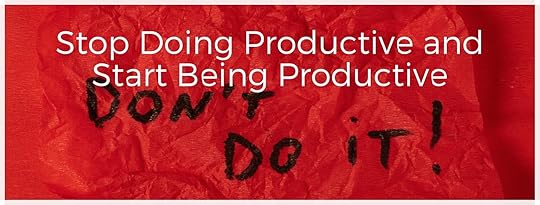
Here’s a typical day for most people:
Wake up
Get ready for work
Go to work
Work
Get ready to go home
Go home
Do “home” work
Have some leisure time
Go to bed
This might be simplifying things, but these are the basics. Sure, some of these things could be arranged in a different order, but they do happen at some point in the day.
But there’s more to it than that.
There are specifics. There are details. There are finer points there than just the itemized list.
Yet we don’t break it down to the specifics – the details – as often as we might want – or should. Instead we just go through the list, checking things off as we go. We strive to get to the end of the list, but another list awaits the very next day.
Over time, we work at getting faster at completing the things on our itemized list. We work at getting out the door faster for work so we can beat traffic. We cram in as much as we can during our leisure time so we can find more enjoyment during our leisure time.
The problem with just adding speed to the mix on its own is that we run the risk of being less effective. When we only add more speed or more details to the things on our list, somehow we lose our ability to be more intentional. We even lose special moments when we always do things with speed.
In our haste to do more, we don’t fully taste what we do.
We consume; we don’t experience. We settle; we don’t savor. All of this means that we “do” productive.
We should “be” productive.
“Life gives you plenty of time to do whatever you want to do if you stay in the present moment.” – Deepak Chopra
While I don’t agree with everything Mr. Chopra talks about, I like what he says about being and how it relates to time. Being is not associated with time.
Rather than spend time speeding things up for the sake of doing, take time to think about whether or not what you are doing is worth you doing at all. Instead of checking off as many boxes as possible, check the boxes you have on your list and make conscious choices about them.
In order to make the above happen – to get that time you need to do whatever you want to do – you need to be aware and have focus. (What’s even more interesting is that you need to be aware to have full focus and you need to have focus in order to be fully aware.)
I’d like to offer a 90 second exercise to help you become aware and find a small measure of focus.
After you’re done reading this piece, just stop and do nothing for 30 seconds. It may help to focus on your breath and close your eyes while doing so. But do this no longer than 30 seconds today.
Grab a piece of paper and a pen/pencil and write down everything you think you need to do, ought to do, or want to do. You should time this. Stop once the 30 seconds is up.
Take another 30 seconds to choose one of those things to work on today. Commit to working on it so that you can honestly say you made progress on it before day’s end.
That’s it. That’s all I want you to do. By doing this, you’re being aware. And by working on just one thing intentionally, you’re exercising focus.
In short, you’re being productive.
The post Stop Doing Productive and Start Being Productive appeared first on Productivityist.
June 13, 2016
The Productivityist Podcast: Hacking Corporate with Nick Snapp
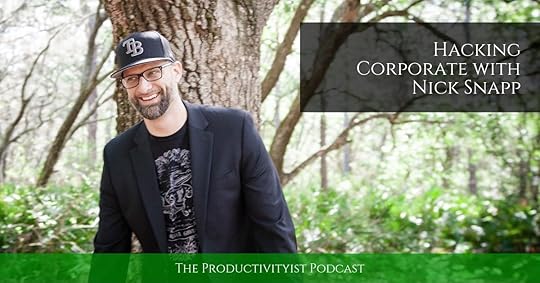
On this episode I speak with Nick Snapp, the host of The Make It Snappy Productivity Show and a productivity strategist who specializes on helping people “hack” Corporate.
Nick’s story is rooted in finding creative ways to “hack” Corporate, escape the office, and still achieve exceptional performance ratings. We talk about the challenges he (and I) have faced translating Corporate skills to personal productivity as entrepreneurs. We also dive into what can help you drive long term successful outcomes, how we focus on family through our processes, setting boundaries, and more.
Relevant Links
The Make it Snappy Productivity Show
Episode 73: Cal Newport | The Productivityist Podcast
Start with Why by Simon Sinek | Amazon
The 12 Week Year by Brian P. Moran and Michael Lennington | Amazon
The One Email You Must Send Before You Go on Vacation | Productivityist
RescueTime
Steve Chandler Audio Programs
Nick Snapp (@thesnappyshow) | Twitter
Productivity on Purpose (P.O.P.) Facebook Group
If you enjoy The Productivityist Podcast I’d appreciate a rating and review in iTunes or your podcasting platform of choice. It helps people find the show easier and will help me make improvements on the show by seeing what you have to say.
Want to help the show even more? Then become a patron The Productivityist Podcast through our Patreon campaign! Check out The Productivityist Podcast’s Patreon page and take a look at all of the perks – available only to Patreon supporters!
The post The Productivityist Podcast: Hacking Corporate with Nick Snapp appeared first on Productivityist.
June 7, 2016
Own Your Time (or Be Owned By It)
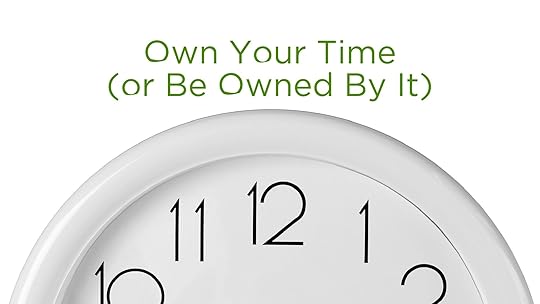
This piece originally appeared in The Productivityist Weekly newsletter. If you’d like to receive first-run and exclusive content delivered to your email inbox every week (and receive additional bonus offers and a free copy of my manifesto The Way of The Productivityist), sign up here.
I spent the better part of my lunch hour yesterday going over old footage and stories of Prince. From the time he appeared on stage with Michael Jackson and James Brown (and stole the show) to his extended performance on Saturday Night Live to his unbelievable guitar solo that was a part of George Harrison’s induction into the Rock and Roll Hall of Fame. There was even one piece of footage that my friend Anthony shared with me where filmmaker Kevin Smith spoke about the time Prince wanted him to work on a documentary with him.
But the one piece of footage that stood out to me was the story of Prince’s halftime performance at Super Bowl 41.
It was raining on that day. A really hard rain. Now, football is an all-weather sport so that wouldn’t be a problem for the players – but it is more of a problem for a concert. But Prince didn’t just perform that day. Prince knocked it out of the park. He gave what was widely considered to be one of the best halftime show ever. It was a masterfully orchestrated show, culminating with a very appropriate song – one of his hits — Purple Rain.
So what does this have to do with productivity? Well, more than you would probably think.
We tend to take on the approaches and habits of others when we are trying to get things done. And when we do this, we can lose sight of the personal aspect of productivity. While we can work as a team to reach a common objective, how each of us works to get there is pretty subjective. If you want to be really productive – which means moving the things forward that you really want to move forward so that you can have a fulfilling life – then you need to infuse your productivity with as much of your own personality as possible. Prince did that with music and the results were astounding. If you take a page out of his book you may surprise yourself with the results you can achieve.
If you want to do things differently so that you can achieve incredible results but you’re afraid to take that step, just make it a small step. Be the person in your office that blocks off part of your day for focused work. Shift the way you communicate at the office so that internal communication happens through one platform like Slack and then external communication happens through email. Figure out which modes serve you best for different types of work that you need to do and use them as your guides, rather than the calendar or the clock.
Do any or all of those things – or do something that is distinctly yours — and then deliver a winning performance as a result of implementing those changes. Not everything is going to be a hit, but you won’t have any hits unless you give it a try.
Life is short. Prince lived to be just 57 years old. Yet look at everything he did in that lifespan. That’s because he lived by the adage that “Time is a mind construct. It’s not real.” I think time is definitely a “created thing” (as Lao Tsu said), so the key is to not worry about the time we have but to invest it wisely while we have it.
The post Own Your Time (or Be Owned By It) appeared first on Productivityist.
June 6, 2016
The Productivityist Podcast: Strategic Storytelling with Jordan Bower
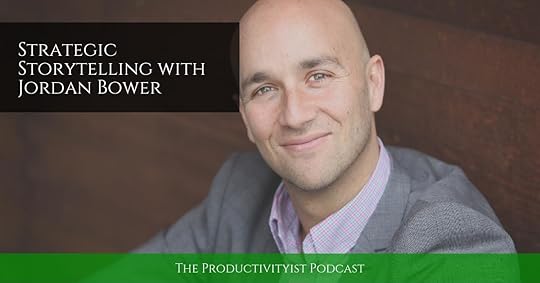
On this episode of the podcast, I speak with Jordan Bower. We talk about the power of story, his approach to storytelling, and much more (including a mention of one of my favourite storytellers, Steven Pressfield).
Jordan is a strategic storyteller now based in my hometown of Victoria. We had a chance to meet up for the first time at Social Media Camp and had a great face to face conversation and I was excited to carry that over to the podcast. (He also has a fascinating story to tell of his own and he shares elements of it in this episode.)
Relevant Links
Jordan Bower: Strategic Storytelling & Corporate Intimacy Expert
About Jordan Bower
Brush with death made Jordan Bower get serious about photos | Toronto Star
Storytelling Approach | Jordan Bower
Rolf Potts’ Vagabonding
Into the Wild by Jon Krakauer | Amazon
Rohdesign | Mike Rohde
Stefan Sagmeister: The power of time off | TED.com
Writing Wednesdays: The Hero’s Journey in Real Life | Steven Pressfield
Jordan Bower (@jordan__bower) | Twitter
If you enjoy The Productivityist Podcast I’d appreciate a rating and review in iTunes or your podcasting platform of choice. It helps people find the show easier and will help me make improvements on the show by seeing what you have to say.
Want to help the show even more? Then become a patron The Productivityist Podcast through our Patreon campaign! Check out The Productivityist Podcast’s Patreon page and take a look at all of the perks – available only to Patreon supporters!
The post The Productivityist Podcast: Strategic Storytelling with Jordan Bower appeared first on Productivityist.
June 2, 2016
The Power Of Quarterly Goals
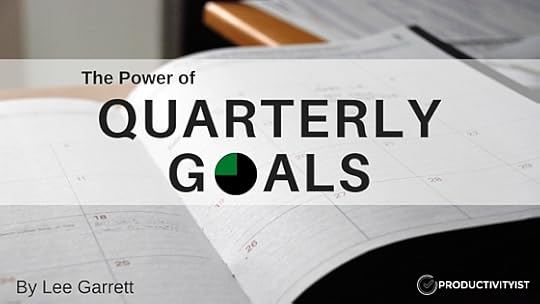
Today’s guest post is by Productivityist contributor Lee Garrett. Lee is a freelance Project Manager, IT Consultant and Productivity Coach based in the South East of England. You can follow him on Twitter @myproductivemac.
Recently I was given the task of clearing out a room in the house so it could be redone. During the process, I had to take all of the waste that was created to the local rubbish dump. There was a metal cabinet that needed to be disposed of in it’s own recycling container that was for scrap metal only. When I reached the container, I was quite surprised at what I saw inside.
I counted four exercise bikes.
This sight made me stop and pause. While doing so, I thought of the time I decided to quit doing New Year resolutions.
Several years ago, on New Year’s Eve, I decided that I needed to lose weight. I’m a former smoker who packed on a few pounds on when I quit, and this has been a genuine source of unhappiness for me. “New Year, New Me” was all that was going through my mind. I wanted to change.
But all I saw in front of me were two things; I saw the figure that I wanted to change as well as the image of a figure I wanted to have. A lean, muscular, athletic fellow that my wife would positively drool over. There was no middle ground. No desire for gradual improvement. I wanted the figure of Adonis and I wanted it NOW.
So my resolution was simple. I decided I was going to lose weight, build muscles, be healthy and gorgeous.
I know what you’re thinking. This statement is loose, unspecific and unrealistic. While I may have had great intentions, the truth is, this goal was never going to work.
Anyhow, my naivety aside, I bought an exercise bike, a gym membership, new running shoes, the works – all because I assumed that buying the right equipment was half of the journey.
Of course, I was wrong.
Without a specific goal and a set date to achieve it, there was no way of maintaining motivation. I’d finish a workout, look at myself in the mirror and see no change. I’d jump on the scales at the end of the week and while there would be a slight improvement, it just wasn’t enough to keep me going. The results simply weren’t happening quickly enough. The end date just seemed too far away to keep me motivated.
I sold my exercise bike on Ebay the following February.
I did, however, resolve to do much better next year.
Shift Your Goals
When I started reading productivity books and began this journey of self-improvement, I realized some of the key mistakes that I had been making. I wasn’t breaking my goals down into manageable targets that were easier to reach. I was concentrating on what I wanted to achieve, but had not planned out the steps I would need to get there.
I needed to set myself some targets that were not so far away, to reduce the view on the horizon. After reading Brian Moran’s book, The 12 Week Year, I decided to adopt quarterly goals.
A quarter of a year – which is 12 weeks or 90 days however you wish to think of it – is long enough to complete a project of some substance. It is also short enough to reduce those feelings of overwhelm that plagued me with yearlong targets. I also realized that by adopting a minimum of two goals per quarter, I was going to complete at least eight projects in the coming year. For someone that was struggling with half-finished work and broken promises, this was a great draw.
Imagine with me for a moment: what if your year was only three months long? Nothing else is planned out after that. Instead, all of your focus is used with laser-like precision for the coming quarter. When I implemented this for the first time, I found that it was far easier to maintain my focus and determination to succeed because the goal wasn’t too far away.
You can achieve A LOT in a quarter.
So far, since I started using quarterly goals, I have:
Set up my personal website and started to generate a small revenue
Written a project management book
Attained two project management certifications
Started my own podcast
Created a writing schedule that allows me to write for third party sites (like this!)
Helped co-author a Slack guide with Dave Caolo and Mike Vardy
Completed some other household and family projects that I won’t bore you with here!
How To Prepare Your Goals
We should all have plans for where we want to be, no matter how high level they may be. David Allen often talks about the 50,000 feet view to describe your life goals. Ideally, your quarterly goals should align with your life goals. Your quarterly goals will obviously not be your grand life plan; however, they should form a stepping stone to get you there. My life plan may be to run my own Project Management Consultancy with a fleet of PMs ready to service the world. While that is not a quarterly goal, the certification I will receive in the next few months is definitely a feasible goal. Each month I can take the next step, and so on.
It is important to define these goals. However, it is equally important to clear a lot of the clutter from your own project list. How many tasks have you undertaken that are simply not current or relevant anymore? Which projects will get you to the place you want to be? Is there anything that you can cut? If so, cut them! Get rid of everything you can so you can be presented with a list of projects that are going to help advance you to your dream.
Keep your Eyes on the Prize
Now that you have a smaller list of projects available to you, focus on one or two for your first quarter. Defer everything else that you can and try to keep no more than a couple under your immediate focus. As you know that you are going to be concentrating on a small set of tasks, coupled with the knowledge that you are going to be coming to the other projects on your list soon enough, you will find that you are able to work on your quarterly goals with less distraction and the desire to procrastinate will be dramatically reduced.
Use Your Mornings
I like to get up early in the mornings, make no mistake about it. So I appreciate these words are easier for me to write than it may be for you to read, however I cannot over-emphasize the importance of working on your key goals as early as possible. For me, getting up before the rest of the family gives me that uninterrupted period of focus that I simply cannot guarantee at any other time of the day. I get at least an hour, sometimes two, where I get myself into the zone and my brain starts to do some mad ninja stuff that betrays how it is at other times of the day! I put it down to the fact I know I’m not going to be disturbed. The phone is on silent, the kids are snoring, my notifications are off on my laptop, and work colleagues aren’t online. It just gets done.
Review
My goals are quarterly, but I review them as part of my weekly review. Once a week, I sit down and look at how I’m performing with them. I ask myself questions like: Am I on schedule? What could I improve? Did I lose focus? I make a note of these results in my journal (I use Day One as my journaling app of choice). Using a journal works for me as I have another weekly task that involves looking back at my journal entries for the last week (as well as for certain tags but that’s a separate story) so this keeps my reviews in one nice, tidy system.
When I first adopted quarterly goals, I was very conservative with the targets I set. I found myself achieving things in half the time I would have expected. I attribute this directly to the fact that I work on a maximum of two goals at any one time.
I’ve now found myself applying this level of focus to other areas of my life. I used to have three or four books in progress at any one time; now I just focus on one book and don’t start another until the first book is completed. As you can guess, I’m now getting through more books than ever. I’m mindful to the fact I should only work on one task at a time rather than split my focus.
This style of targeted living has made a dramatic difference to many aspects of my life and I highly recommend it.
The post The Power Of Quarterly Goals appeared first on Productivityist.
May 30, 2016
The Productivityist Podcast: Good to Greatist with Derek Flanzraich

In this episode I speak with Derek Flanzraich, the founder/CEO of Greatist. We talk about the idea of planning, time chunking, and many other things that allow us to push our intentions forward (and allow him to embody the term “greatist”).
This is definitely more of a conversation than an interview, as Derek and I exchange ideas and thoughts on making choices, being productive, and how we make sure we allocate attention to push our intentions forward. So if you’re looking for a straight up interview, you won’t find it here.
I’m looking forward to having Derek back on again in the not-too-distant future as we have a lot more to talk about!
Relevant Links
Greatist
I Got Six-Pack Abs in Six Weeks. Here’s How I Feel One Year Later | Greatist
More Than Marketing, Millennials Are the Economic Future | Inc.com
How to Fail at Almost Everything and Still Win Big: Kind of the Story of My Life by Scott Adams | Amazon
The More of Less with Joshua Becker | The Productivityist Podcast
What is Greatist?
Time Chunking | Productivityist
The Rock Clock | Project Rock
My Three Words for 2016 | Productivityist
What is a Pensieve? | Pottermore
The Hacked-Together Productivity Tool I Can’t Live Without: My Master Planner
How a Themed Schedule Can Help You Stay on Task | Workshifting
Think Productive with Graham Allcott | The Productivityist Podcast
Body Talk with James Hamblin | The Productivityist Podcast
Derek Flanzraich (@thederek) | Twitter
If you enjoy The Productivityist Podcast I’d appreciate a rating and review in iTunes or your podcasting platform of choice. It helps people find the show easier and will help me make improvements on the show by seeing what you have to say.
Want to help the show even more? Then become a patron The Productivityist Podcast through our Patreon campaign! Check out The Productivityist Podcast’s Patreon page and take a look at all of the perks – available only to Patreon supporters!
The post The Productivityist Podcast: Good to Greatist with Derek Flanzraich appeared first on Productivityist.
May 26, 2016
How to Tame Your Inner Critic to Boost Your Productivity

Today’s guest post is by Tom Casano. Tom is the founder of Life Coach Spotter where you can find a coach to be happier, reach your goals, and find your true self.
Ever wonder why you can be extremely productive in some areas while you find yourself stuck in others? The underlying reason is one of the biggest roadblocks you’ll ever have: Your inner critic. You are your biggest critic. While that can be helpful at times, in most cases your method of critique doesn’t work. You need to find ways to tame your inner critic. When you train your brain to only respond in helpful ways to these negative thoughts, it will increase your productivity in a huge way and also give you the ability to keep moving even through the tough stuff.
Use Your Mind
There is no question that self-doubt holds you back. Research has found that negative events or emotions stick in our brains more than positive events or emotions. In other words, you will remember the time you got cut from a team more vividly than if you had made the team. It’s scientifically proven that your brain holds onto the bad moments more intensely and this causes aversions and mental blocks that hold you back from succeeding.
Self-doubt also gets trapped in your head through repetitive, destructive thoughts. The inner critic can wreak havoc in your mind and diminish your ability to progress in certain areas. By better understanding your inner critic and learning how to tame it, you can train it to help you rather than a hindrance.
Stop Giving Your Inner Critic Power
We are often our own worst critic and tend to let the inner critic hold too much power. It’s easy to find reasons to not do new things or to continue to work on something when we already have convinced ourselves it won’t work out. When you allow the critical part of your mind to overrule the creative parts of your mind, you will give up on projects before you finish them. You won’t even give yourself a chance to fail.
Do Something About It
In order to not let the inner critic inhibit you, it’s necessary to actively recognize and respond to it. This approach is not about eliminating self-critique. Rather, it’s all about understanding if it can help you or not and how to handle it.
Here are some practical steps that help you become more intentional about what critical thoughts you listen to:
1. Recognition
When a critical thought comes up, recognize it. Then take a few moments to understand it. Why do you REALLY feel that way? Take each critique on a case by case basis and evaluate them as they come. What prompted that thought?
Did you oversleep for the 3rd time in a row and call yourself a failure? Think about the action and the response and if that response is helpful to moving you forward. It doesn’t matter if you think the critique is true; simply focus on if it’s helpful. Although you really might think of yourself as a failure for sleeping in, letting that critique take root in your mind will not help you.
When you internalize a negative thought, you will often beat yourself up mentally, have a rough day, not sleep well and then continue the cycle. Now that you’ve noticed this critique and that it isn’t helpful, your next step is to be intentional about how you deal with that critique.
2. Intentionality
Now that you’ve noticed your first negative internal response, you can then deal with it in an intentional and constructive manner. At this point you can discredit the response as being unhelpful. Train yourself to recognize what isn’t useful. Feel free to vocalize that it isn’t moving you forward and then challenge yourself to find a better response.
A better response is one that is honest, yet moves you towards progress. You can determine that you won’t let your accidental snooze ruin your day. Even better, make an action plan by scheduling time that day to look up techniques to not oversleep or find better alarm apps. These steps will ultimately leave you feeling hopeful rather than defeated, and THAT is helpful.
3. Consistency
The power in recognizing and replacing unhelpful self-criticism lies in repetition and consistency. You got yourself into the habit of negative and unhelpful responses so you’ll have to put in the time and effort to build new habits to override the old ones. One thing you can do now to tackle this is to set a reminder in your phone every morning. Journaling on a regular basis is a very powerful tool that can help you move forward.
Remind yourself to be aware throughout your day and this can help guide you away from any bad thought patterns. If you don’t have time to evaluate your negative and critical thoughts on the spot, you can jot down each individual instance and reaction as they come up and then tackle them later. Use a convenient note-taking app on your phone like Evernote or even your phone calendar, then set a time to check those notes. You won’t always have time to stop and analyze in every situation so take notes to ensure you’ll remember to evaluate them later.
Of course, not all self-critique is bad. You aren’t completely evicting your inner critic, you are house-training it and teaching it some manners. Well constructed critique can help you make progress and get through challenges. This isn’t about denying that you fail and refusing to accept critique. You are simply trying to make better use of your inner critic by limiting its power to only things it can be helpful towards.
Don’t shut down all self-critical thoughts, just the unhelpful ones.
The goal is to avoid that feeling of defeat that useless critiques give you. This feeling is all too limiting and can discourage forward motion in many areas of your life. If you’ve been hung up on a project, goal or decision for a while and can’t seem to move forward, chances are, your inner critic is to blame. Don’t let your inner critic keep wasting your time, set up daily reminders right now and start observing and evaluating. Train your inner critic to transition from self-defeating to motivating and you’ll find that you make much more progress in difficult areas of your life.
The post How to Tame Your Inner Critic to Boost Your Productivity appeared first on Productivityist.
May 24, 2016
The Voice You Can Trust

The voice that you must trust the most is the one that combines the voice from the past and the voice from the present.
The voice from the past is the one that at least gave some thought to some of the intentions that you had. This voice wanted to ensure that you – in the present day – would give these intentions some form of your attention.
Now this doesn’t mean that you necessarily do these things you intended. The point is that your past self made the effort to get ideas or thoughts out of your head and so you could evaluate them better later on. This is the voice from the past that reminds you of what you were thinking before hand.
When you are reflective, you have a better chance of staying on course.
The voice of today can only look at the present moment. It doesn’t have all of the knowledge or wisdom to move forward in the best way possible unless it looks toward the voice from the past. Again, it is that thoughtfulness that will allow you to make better choices on what your past intentions were.
In order to move forward with both intentions and attention existing in harmony, the voice from the past that must have a say.
Think of each of these voices as the vocal components of a song. One is the melody – the part of the song that is easy to recall and sing with little effort if you hear it often enough. The other is the harmony (or one harmony since you can have several harmonies in a song). It’s the aspect of the song that you can only deliver well if you know the melody well enough and have the experience and wisdom to know when it should be heard and when it should stay quiet.
Each of these voices sound fine on their own if you’re a good singer, but they sound much better when they are combined together.
All of the formative aspects of the song come from the melody, which is created first. The harmony can only come into existence after the melody has been sung.
So the next time you have an idea or thought in present day, go ahead and capture it. Later on this thought or idea could prove to be invaluable. You are doing your future self a disservice when you don’t get thoughts out of your head as soon as possible. It’s like you’re giving your future self a valuable document but some of the notes are blacked out.
And those missing notes can make all the difference in between an average song and an exceptional song that captivates you.
The post The Voice You Can Trust appeared first on Productivityist.
May 23, 2016
The Productivityist Podcast: Priorities with Erik Fisher and Steve Dotto
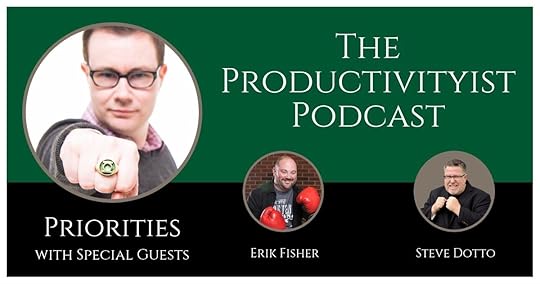
On this episode of The Productivityist Podcast, I’m featuring the Productivity Powerhouse Panel Blab that Steve Dotto (DottoTech) and Erik Fisher (Beyond The To Do List) did with me on the topic of priorities.
This episode is a little longer than usual – these panel discussions last an hour – and the audio quality will be different because it is ripped from the Blab we did.
You’ll hear Steve challenge me about how I use time theming and the three of us dive deep into how we deal with prioritization every day.
If you enjoy The Productivityist Podcast I’d appreciate a rating and review in iTunes or your podcasting platform of choice. It helps people find the show easier and will help me make improvements on the show by seeing what you have to say.
Want to help the show even more? Then become a patron The Productivityist Podcast through our Patreon campaign! Check out The Productivityist Podcast’s Patreon page and take a look at all of the perks – available only to Patreon supporters!
The post The Productivityist Podcast: Priorities with Erik Fisher and Steve Dotto appeared first on Productivityist.

